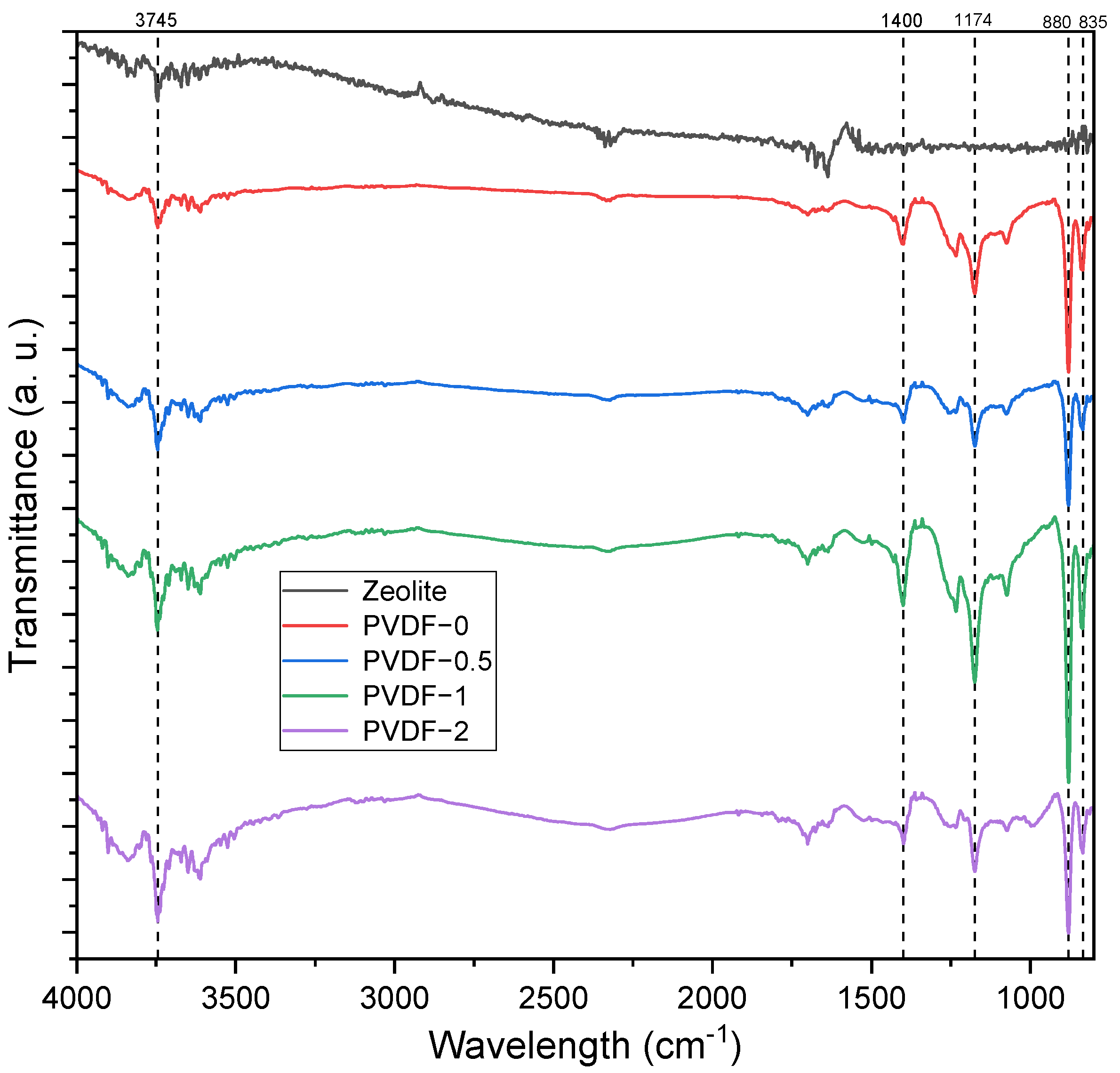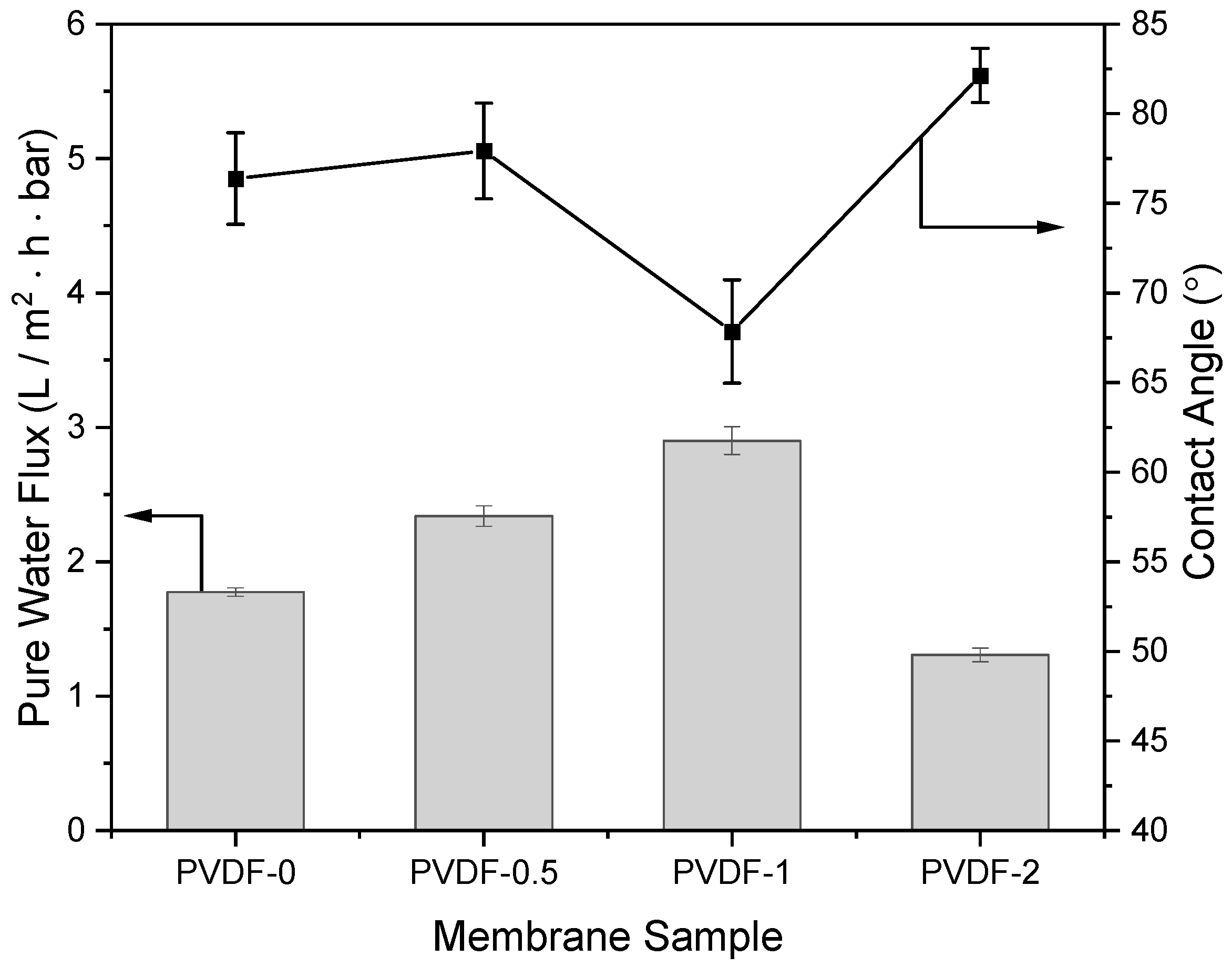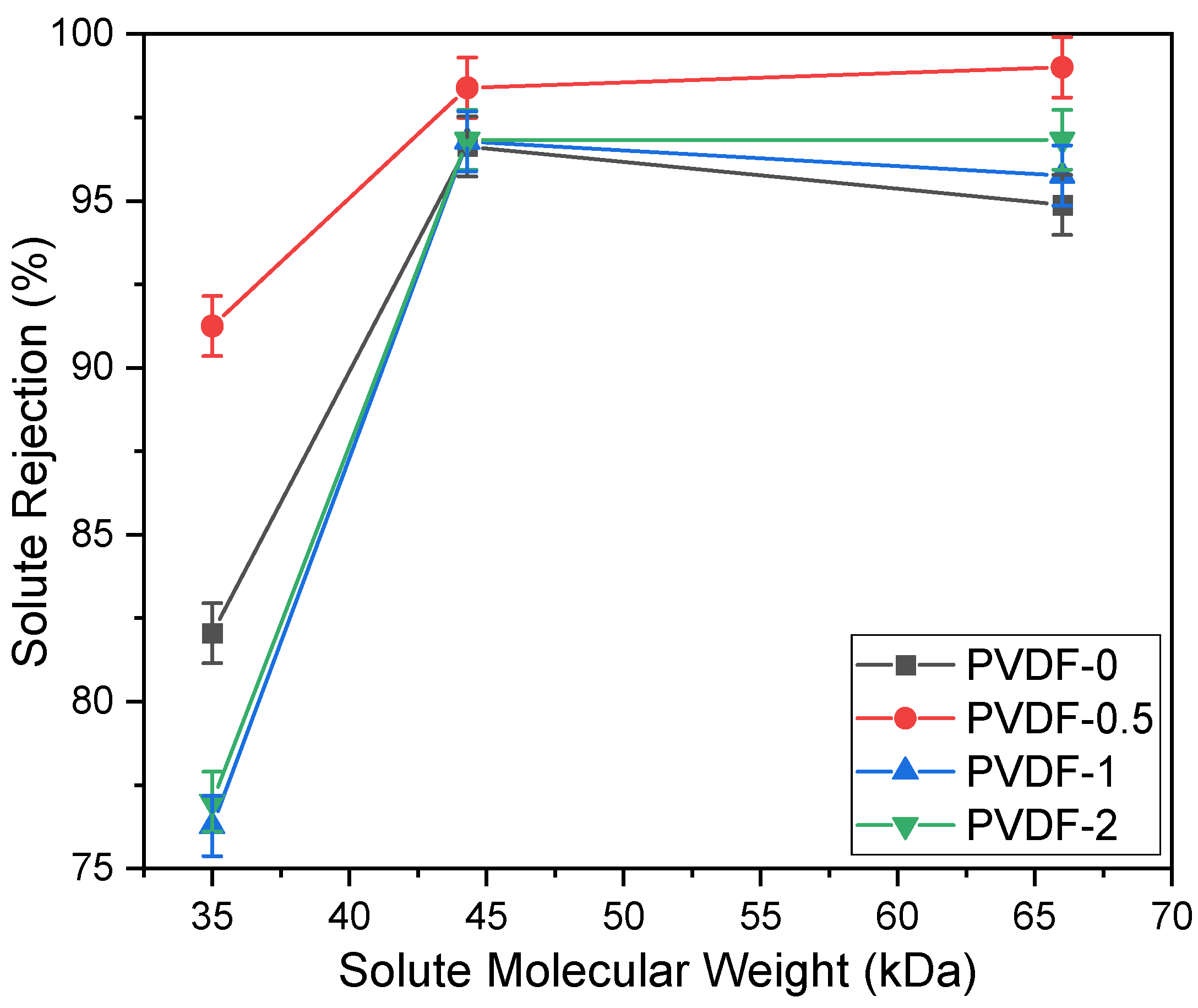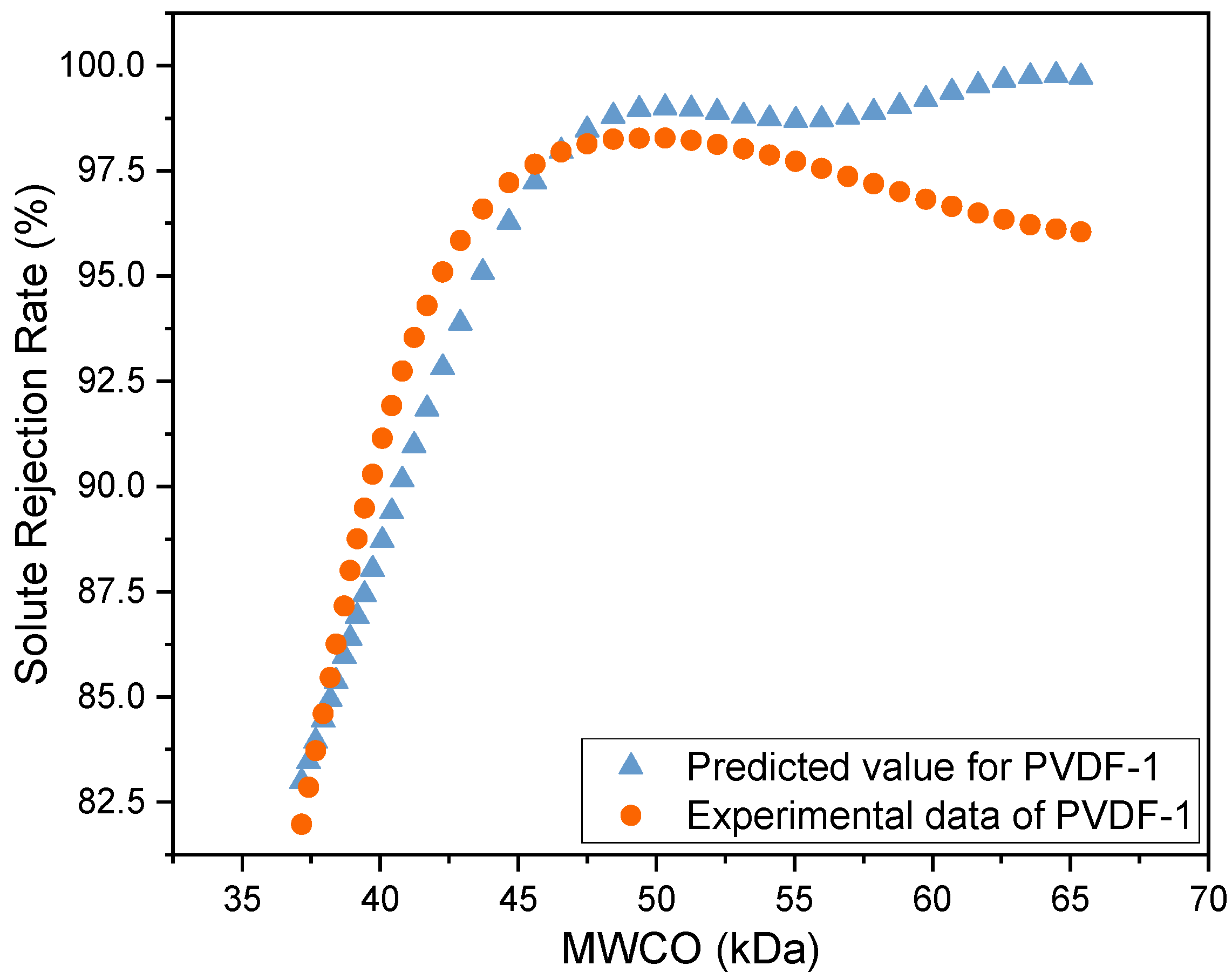Zeolite-Based Poly(vinylidene fluoride) Ultrafiltration Membrane: Characterization and Molecular Weight Cut-Off Estimation with Support Vector Regression Modelling
Abstract
:1. Introduction
2. Experimental Methods
2.1. Materials
2.2. Preparation of Polymer Solution
2.3. Membrane Fabrication by Dry–Wet Phase Inversion Method
2.4. Membrane Characterisation Methods
2.4.1. Fourier Transform Infrared (FTIR) Spectroscopy
2.4.2. Field Emission Scanning Electron Microscopy (FESEM) Imaging
2.4.3. Membrane Contact Angle Analysis
2.4.4. Pure Water Flux (PWF) Analysis
2.4.5. Solute Rejection and Molecular Weight Cut-Off (MWCO) Analysis
2.4.6. Machine Learning Model for MWCO Prediction
2.4.7. Mechanical Properties
3. Results and Discussion
3.1. FTIR Spectra of Zeolite-Modified PVDF Membranes
3.2. Membrane Morphology
3.3. Contact Angle and Pure Water Flux Analysis
3.4. Solute Rejection Performance
3.5. Prediction of MWCO of Zeolite-Modified Membrane Using SVR Model
3.6. Mechanical Properties of Zeolite-Modified Membranes
4. Conclusions
Author Contributions
Funding
Institutional Review Board Statement
Data Availability Statement
Conflicts of Interest
References
- Ozbey-Unal, B.; Omwene, P.I.; Yagcioglu, M.; Balcik-Canbolat, Ç.; Karagunduz, A.; Keskinler, B.; Dizge, N. Treatment of organized industrial zone wastewater by microfiltration/reverse osmosis membrane process for water recovery: From lab to pilot scale. J. Water Process Eng. 2020, 38, 101646. [Google Scholar] [CrossRef]
- Ghodke, Y.A.; Mayilswamy, N.; Kandasubramanian, B. Polyamide (PA)- and Polyimide (PI)-based membranes for desalination application. Polym. Bull. 2023, 80, 10661–10695. [Google Scholar] [CrossRef]
- Rezaei-DashtArzhandi, M.; Ismail, A.F.; Goh, P.S.; Wan Azelee, I.; Abbasgholipourghadim, M.; Ur Rehman, G.; Matsuura, T. Zeolite ZSM5-Filled PVDF Hollow Fiber Mixed Matrix Membranes for Efficient Carbon Dioxide Removal via Membrane Contactor. Ind. Eng. Chem. Res. 2016, 55, 12632–12643. [Google Scholar] [CrossRef]
- Nayak, K.; Kumar, A.; Tripathi, B.P. Molecular grafting and zwitterionization based antifouling and underwater superoleophobic PVDF membranes for oil/water separation. J. Membr. Sci. 2022, 643, 120038. [Google Scholar] [CrossRef]
- Mansha, M.; Salhi, B.; Ali, S.; Khan, S.A.; Baig, N. Novel procaine-based gemini zwitterion incorporated PVDF membranes for efficient treatment of oily wastewater. J. Environ. Chem. Eng. 2022, 10, 107935. [Google Scholar] [CrossRef]
- Lau, S.K.; Jia, T.-Z.; Cao, X.-L.; Sun, S.-P.; Yong, W.F. Sustainable fabrication of zwitterionic nanofiltration membranes with enhanced antifouling performance using sugar. J. Environ. Chem. Eng. 2023, 11, 110588. [Google Scholar] [CrossRef]
- Hashino, M.; Hirami, K.; Ishigami, T.; Ohmukai, Y.; Maruyama, T.; Kubota, N.; Matsuyama, H. Effect of kinds of membrane materials on membrane fouling with BSA. J. Membr. Sci. 2011, 384, 157–165. [Google Scholar] [CrossRef]
- Gao, F.; Wang, J.; Zhang, H.; Zhang, Y.; Hang, M.A. Effects of sodium hypochlorite on structural/surface characteristics, filtration performance and fouling behaviors of PVDF membranes. J. Membr. Sci. 2016, 519, 22–31. [Google Scholar] [CrossRef]
- Rabuni, M.F.; Nik Sulaiman, N.M.; Aroua, M.K.; Yern Chee, C.; Awanis Hashim, N. Impact of in situ physical and chemical cleaning on PVDF membrane properties and performances. Chem. Eng. Sci. 2015, 122, 426–435. [Google Scholar] [CrossRef]
- Nthunya, L.N.; Gutierrez, L.; Lapeire, L.; Verbeken, K.; Zaouri, N.; Nxumalo, E.N.; Mamba, B.B.; Verliefde, A.R.; Mhlanga, S.D. Fouling-resistant PVDF nanofibre membranes for the desalination of brackish water in membrane distillation. Sep. Purif. Technol. 2019, 228, 115793. [Google Scholar] [CrossRef]
- Goh, P.S.; Ismail, A.F. Chemically functionalized polyamide thin film composite membranes: The art of chemistry. Desalination 2020, 495, 114655. [Google Scholar] [CrossRef]
- Ma, C.; Hu, J.; Sun, W.; Ma, Z.; Yang, W.; Wang, L.; Ran, Z.; Zhao, B.; Zhang, Z.; Zhang, H. Graphene oxide-polyethylene glycol incorporated PVDF nanocomposite ultrafiltration membrane with enhanced hydrophilicity, permeability, and antifouling performance. Chemosphere 2020, 253, 126649. [Google Scholar] [CrossRef] [PubMed]
- Szwast, M.; Polak, D.; Arciszewska, W.; Zielińska, I. Novel PVDF-PEG-CaCO3 Membranes to Achieve the Objectives of the Water Circular Economy by Removing Pharmaceuticals from the Aquatic Environment. Membranes 2023, 13, 44. [Google Scholar] [CrossRef] [PubMed]
- Zagho, M.M.; Hassan, M.K.; Khraisheh, M.; Al-Maadeed, M.A.A.; Nazarenko, S. A review on recent advances in CO2 separation using zeolite and zeolite-like materials as adsorbents and fillers in mixed matrix membranes (MMMs). Chem. Eng. J. Adv. 2021, 6, 100091. [Google Scholar] [CrossRef]
- Sun, Z.; Wang, P.; Lu, D.; Liu, C.; Ma, J. Synergistic effects of matrix-anchoring and surface-segregation behavior of poly(N-vinylpyrrolidone)-grafted-silica filler for PVDF membrane performance improvement. Sep. Purif. Technol. 2021, 276, 119353. [Google Scholar] [CrossRef]
- Vatanpour, V.; Esmaeili, M.; Chahvari, S.; Masteri-Farahani, M. Evaluation of morphology, performance and fouling tendency of mixed matrix PVDF ultrafiltration membranes incorporated by different size-controlled SAPO-34 nanozeolites. J. Environ. Chem. Eng. 2021, 9, 105900. [Google Scholar] [CrossRef]
- Zhu, Y.; Jian, M.; Meng, N.; Ji, Y.; Bai, X.; Wu, L.; Yang, H.; Tan, C.; Li, H. Recent progress in developing 2D MOFs/COFs/Zeolites nanosheets membranes for water purification. Sep. Purif. Technol. 2024, 337, 126404. [Google Scholar] [CrossRef]
- Shi, H.; Liu, F.; Xue, L. Fabrication and characterization of antibacterial PVDF hollow fibre membrane by doping Ag-loaded zeolites. J. Membr. Sci. 2013, 437, 205–215. [Google Scholar] [CrossRef]
- Zhan, X.; Li, J.-d.; Chen, J.; Huang, J.-q. Pervaporation of Ethanol/Water Mixtures with High Flux by Zeolite-Filled PDMS/PVDF Composite Membranes. Chin. J. Polym. Sci. 2009, 27, 771–780. [Google Scholar] [CrossRef]
- Huang, L.; Arena, J.T.; Manickam, S.S.; Jiang, X.; Willis, B.G.; McCutcheon, J.R. Improved mechanical properties and hydrophilicity of electrospun nanofiber membranes for filtration applications by dopamine modification. J. Membr. Sci. 2014, 460, 241–249. [Google Scholar] [CrossRef]
- Shi, W.; Gao, F.; Li, X.; Wang, Z. High zeolite loading mixed matrix membrane for effective removal of ammonia from surface water. Water Res. 2022, 221, 118849. [Google Scholar] [CrossRef] [PubMed]
- Irfan, M.; Basri, H.; Irfan, M. An Experimental Investigation: Effect of Phase Inversion Methods on Membrane Structure and Its Performance on PEG Filtration. J. Appl. Membr. Sci. Technol. 2015, 17, 17–23. [Google Scholar] [CrossRef]
- Pinnau, I.; Koros, W.J. A qualitative skin layer formation mechanism for membranes made by dry/wet phase inversion. J. Polym. Sci. Part B Polym. Phys. 1993, 31, 419–427. [Google Scholar] [CrossRef]
- Itta, A.K.; Tseng, H.-H.; Wey, M.-Y. Effect of dry/wet-phase inversion method on fabricating polyetherimide-derived CMS membrane for H2/N2 separation. Int. J. Hydrogen Energy 2010, 35, 1650–1658. [Google Scholar] [CrossRef]
- Gaucheron, F. MILK SALTS | Distribution and Analysis. In Encyclopedia of Dairy Sciences (Second Edition); Fuquay, J.W., Ed.; Academic Press: San Diego, CA, USA, 2011; pp. 908–916. [Google Scholar]
- Koyuncu, I.; Sengur, R.; Turken, T.; Guclu, S.; Pasaoglu, M.E. 3–Advances in water treatment by microfiltration, ultrafiltration, and nanofiltration. In Advances in Membrane Technologies for Water Treatment; Basile, A., Cassano, A., Rastogi, N.K., Eds.; Woodhead Publishing: Oxford, UK, 2015; pp. 83–128. [Google Scholar]
- Fadel, M.; Wyart, Y.; Moulin, P. An Efficient Method to Determine Membrane Molecular Weight Cut-Off Using Fluorescent Silica Nanoparticles. Membranes 2020, 10, 271. [Google Scholar] [CrossRef]
- Dansawad, P.; Li, Y.; Li, Y.; Zhang, J.; You, S.; Li, W.; Yi, S. Machine learning toward improving the performance of membrane-based wastewater treatment: A review. Adv. Membr. 2023, 3, 100072. [Google Scholar] [CrossRef]
- Yin, H.; Xu, M.; Luo, Z.; Bi, X.; Li, J.; Zhang, S.; Wang, X. Machine learning for membrane design and discovery. Green Energy Environ. 2024, 9, 54–70. [Google Scholar] [CrossRef]
- Uçak, K.; Günel, G.Ö. Adaptive stable backstepping controller based on support vector regression for nonlinear systems. Eng. Appl. Artif. Intell. 2024, 129, 107533. [Google Scholar] [CrossRef]
- Huo, D.; Chen, J.; Wang, T. Chaos-based support vector regression for load power forecasting of excavators. Expert Syst. Appl. 2024, 246, 123169. [Google Scholar] [CrossRef]
- Mieowkee, C.; Raoo, P.; Eu, Y.K.; Lim, J.M.-Y. A Novel Manufacturing Process to Fabricate Double-Layer Membranes. Mater. Manuf. Process. 2016, 31, 1941–1947. [Google Scholar] [CrossRef]
- ASTM D882; Standard Test Method for Tensile Properties of Thin Plastic Sheeting. ASTM International: West Conshohocken, PA, USA, 2012.
- Amiri, F.; Moghadassi, A.; Bagheripour, E.; Parvizian, F. Fabrication and Characterization of PES Based Nanofiltration Membrane Modified by Zeolite Nanoparticles for Water Desalination. J. Membr. Sci. Res. 2017, 3, 50–56. [Google Scholar]
- Wang, Y.; Rong, H.; Sun, L.; Zhang, P.; Yang, Y.; Jiang, L.; Wu, S.; Zhu, G.; Zou, X. Fabrication and evaluation of effective zeolite membranes for water desalination. Desalination 2021, 504, 114974. [Google Scholar] [CrossRef]
- Rabiee, H.; Vatanpour, V.; Farahani, M.H.D.A.; Zarrabi, H. Improvement in flux and antifouling properties of PVC ultrafiltration membranes by incorporation of zinc oxide (ZnO) nanoparticles. Sep. Purif. Technol. 2015, 156, 299–310. [Google Scholar] [CrossRef]
- Anis, S.F.; Hashaikeh, R.; Hilal, N. Flux and salt rejection enhancement of polyvinyl(alcohol) reverse osmosis membranes using nano-zeolite. Desalination 2019, 470, 114104. [Google Scholar] [CrossRef]
- Chan, M.; Ooi, C. Reusability of Nano-Fe3O4/Polyvinylidene Difluoride Membrane for Palm Oil Mill Effluent Treatment. Trends Sci. 2022, 19, 4636. [Google Scholar] [CrossRef]
- Eckstein, F.; Wunderer, C.; Boehm, H.; Kuhn, V.; Priemel, M.; Link, T.M.; Lochmüller, E.M. Reproducibility and Side Differences of Mechanical Tests for Determining the Structural Strength of the Proximal Femur. J. Bone Miner. Res. 2004, 19, 379–385. [Google Scholar] [CrossRef]
- Fernandes, A.P.; Fonseca, A.R.; Pacheco, F.A.L.; Sanches Fernandes, L.F. Water quality predictions through linear regression—A brute force algorithm approach. Methods X 2023, 10, 102153. [Google Scholar] [CrossRef] [PubMed]
- Islam Khan, M.S.; Islam, N.; Uddin, J.; Islam, S.; Nasir, M.K. Water quality prediction and classification based on principal component regression and gradient boosting classifier approach. J. King Saud Univ. Comput. Inf. Sci. 2022, 34, 4773–4781. [Google Scholar] [CrossRef]
- Noh, H.; Son, G.; Kim, D.; Park, Y.S. H-ADCP-based real-time sediment load monitoring system using support vector regression calibrated by global optimization technique and its applications. Adv. Water Resour. 2024, 185, 104636. [Google Scholar] [CrossRef]
- Deng, Y.; Gao, X.; Tu, T. Enhancing skeletal age estimation accuracy using support vector regression models. Leg. Med. 2024, 66, 102362. [Google Scholar] [CrossRef]
- Nassrullah, H.; Makanjuola, O.; Janajreh, I.; AlMarzooqi, F.A.; Hashaikeh, R. Incorporation of nanosized LTL zeolites in dual-layered PVDF-HFP/cellulose membrane for enhanced membrane distillation performance. J. Membr. Sci. 2020, 611, 118298. [Google Scholar] [CrossRef]
- Kadja, G.T.M.; Dwihermiati, E.; Sagita, F.; Mukhoibibah, K.; Umam, K.; Ledyastuti, M.; Radiman, C.L. Mercapto functionalized–natural zeolites/PVDF mixed matrix membrane for enhanced removal of methylene blue. Inorg. Chem. Commun. 2023, 157, 111263. [Google Scholar] [CrossRef]
- Zhang, J.; Xiang, Y.; Jamil, M.I.; Lu, J.; Zhang, Q.; Zhan, X.; Chen, F. Polymers/zeolite nanocomposite membranes with enhanced thermal and electrochemical performances for lithium-ion batteries. J. Membr. Sci. 2018, 564, 753–761. [Google Scholar] [CrossRef]
- Karimi, A.; Khataee, A.; Safarpour, M.; Vatanpour, V. Development of mixed matrix ZIF-8/polyvinylidene fluoride membrane with improved performance in solvent resistant nanofiltration. Sep. Purif. Technol. 2020, 237, 116358. [Google Scholar] [CrossRef]
- Kim, J.F.; Kim, J.H.; Lee, Y.M.; Drioli, E. Thermally induced phase separation and electrospinning methods for emerging membrane applications: A review. AIChE J. 2016, 62, 461–490. [Google Scholar] [CrossRef]
- Gu, Q.; Kotobuki, M.; Kirk, C.H.; He, M.; Lim, G.J.H.; Ng, T.C.A.; Zhang, L.; Ng, H.Y.; Wang, J. Overcoming the Trade-off between Water Permeation and Mechanical Strength of Ceramic Membrane Supports by Interfacial Engineering. ACS Appl. Mater. Interfaces 2021, 13, 29199–29211. [Google Scholar] [CrossRef]






| Membrane Designation | PVDF (wt%) | PEG (wt%) | DMF (wt%) | Zeolite (wt%) |
|---|---|---|---|---|
| PVDF-0 | 16.5 | 6 | 77.5 | 0 |
| PVDF-0.5 | 16.5 | 6 | 77 | 0.5 |
| PVDF-1 | 16.5 | 6 | 76.5 | 1 |
| PVDF-2 | 16.5 | 6 | 75.5 | 2 |
| Zeolite Concentration (wt%) | MWCO (X) | Rejection Rate, % (Y) | Number of Data |
|---|---|---|---|
| 0.0 | 35,108–65,634 | 82–97 | 42 |
| 0.5 | 35,541–66,794 | 91–100 | 34 |
| 1.0 | 35,142–46,552 | 76–98 | 29 |
| 2.0 | 35,224–64,517 | 78–98 | 47 |
| Compound | Characteristic Peak (cm−1) | Band Assignment | Total Area within the Range of 1584.45 cm−1 to 1789.55 cm−1 (O-H) Lattice Water (%T·cm−1) | Total Area within the Range of 3500 cm−1 to 3903.5 cm−1 (O-H Group) (%T·cm−1) |
|---|---|---|---|---|
| Zeolite | 1636.63 | (O–H) lattice water | 20,528.68 | - |
| PVDF-0 | 1174.52 | C–C group | ||
| 879.71 | C–C–C asymmetrical stretching vibration | 20,538.65 | - | |
| PVDF-0.5 | 3745.36 | O–H group | ||
| 1174.30 | C–C group | 20,714.14 | 40,742.91 | |
| 879.62 | C–C–C asymmetrical stretching vibration | |||
| PVDF-1 | 3745.47 | O–H group | ||
| 1399.86 | CH2 wagging vibration | |||
| 1174.72 | C–C group | |||
| 879.52 | C–C–C asymmetrical stretching vibration | 20,827.06 | 40,875.65 | |
| 835.95 | C–F stretching vibration | |||
| PVDF-2 | 3745.01 | O–H group | ||
| 1174.43 | C–C group | |||
| 879.59 | C–C–C asymmetrical stretching vibration | 20,528.68 | 40,441.58 | |
| 835.74 | C–F stretching vibration |
| Training-Testing Dataset Ratio | R2 | MSE |
|---|---|---|
| 60:40 | 0.8548 | 3.5885 |
| 70:30 | 0.8796 | 2.9759 |
| 80:20 | 0.9139 | 2.1277 |
Disclaimer/Publisher’s Note: The statements, opinions and data contained in all publications are solely those of the individual author(s) and contributor(s) and not of MDPI and/or the editor(s). MDPI and/or the editor(s) disclaim responsibility for any injury to people or property resulting from any ideas, methods, instructions or products referred to in the content. |
© 2024 by the authors. Licensee MDPI, Basel, Switzerland. This article is an open access article distributed under the terms and conditions of the Creative Commons Attribution (CC BY) license (https://creativecommons.org/licenses/by/4.0/).
Share and Cite
Chan, M.K.; Tan, S.J.; Yeow, A.T.H.; Ng, S.C.; Lau, W.J. Zeolite-Based Poly(vinylidene fluoride) Ultrafiltration Membrane: Characterization and Molecular Weight Cut-Off Estimation with Support Vector Regression Modelling. Membranes 2024, 14, 91. https://doi.org/10.3390/membranes14040091
Chan MK, Tan SJ, Yeow ATH, Ng SC, Lau WJ. Zeolite-Based Poly(vinylidene fluoride) Ultrafiltration Membrane: Characterization and Molecular Weight Cut-Off Estimation with Support Vector Regression Modelling. Membranes. 2024; 14(4):91. https://doi.org/10.3390/membranes14040091
Chicago/Turabian StyleChan, Mieow Kee, Syee Jia Tan, Andrew T. H. Yeow, Sok Choo Ng, and Woei Jye Lau. 2024. "Zeolite-Based Poly(vinylidene fluoride) Ultrafiltration Membrane: Characterization and Molecular Weight Cut-Off Estimation with Support Vector Regression Modelling" Membranes 14, no. 4: 91. https://doi.org/10.3390/membranes14040091






